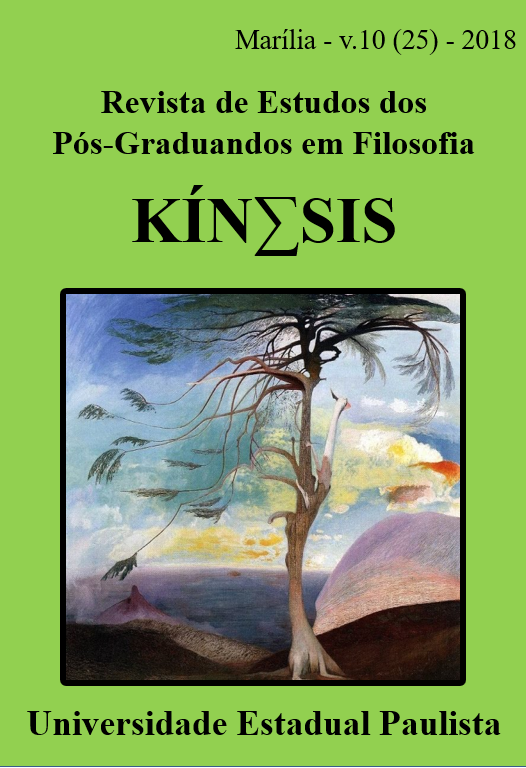THE EMERGENCE OF ARTIFICIAL CONSCIOUSNESS AND ITS IMPORTANCE TO REACH THE TECHNOLOGICAL SINGULARITY
DOI:
https://doi.org/10.36311/1984-8900.2018.v10.n25.08.p111Palavras-chave:
Artificial Intelligence, Machine discovery, Turing test, Chinese Room, IntentionalityResumo
The men admired a way to swim the fish, but today they sail faster than anyone. They'd like flying like the birds, but have been a lot higher. They searched for wisdom, now they have all the knowledge accumulated in the story available in a few clicks. Human evolution is about to meet its peak through the Technological Singularity, which can be understood as the future milestone reached at the moment that a computer program can think like a human, yet with quick access to all information already registered by society. It will not be like a man, but more intelligent than all mankind in history. So we have a big question: will this new entity has consciousness? Through a study of the levels of intelligent agents autonomy and in a timeless dialogue with Alan Turing, René Descartes, Ludwic Wittgenstein, John Searle and Vernor Vinge, we show the possibility of an artificial consciousness and that
the quest for intentionality, promoted by sophisticated algorithms of learning and machine discovery, is the key to reach of Technological Singularity.
Downloads
Referências
ABADI, M.; ANDERSEN, D. Learning to protect communications with adversarial neural cryptography. ArXiv preprint arXiv, 1612.06918, 2016
BAKER, G.; HACKER, P. Wittgenstein Meaning and Understanding. Essays on the Philosophical Investigations, Vol. 1. University of Chicago Press, 1983.
BLOCK, N.; FODOR, J. A. What psychological states are not. In: BLOCK, N. (Org.). Readings in Philosophy of Psychology. Cambridge: Harvard University Press, v. 1, 1980.
BLOCK, N. What is functionalism? Readings in Philosophy of Psychology. Cambridge: Harvard University Press, 1980.
BUTTAZZO, G. Artificial consciousness: Utopia or real possibility? Computer, v. 34, n. 7, p. 24-30, 2001.
CANAL, R. Quatro objeções de John Searle ao cognitivismo. Kínesis, Vol. I, n° 01, Março / 2009, p.171-185.
CLARK, A. Mindware: an introduction to the philosophy of cognitive science. New York. Oxford University Press. 2001.
CLIFF, D.; HUSBANDS, P. e HARVEY, I. Explorações na Robótica Evolutiva. Adaptive Behavior, 2 (1):73–110. 1993.
DENNETT, D. Consciousness explained. Little, Brown, 2017.
DESCARTES, R. Discurso del método. Ediciones Colihue SRL, 2004.
EDEN, A.; STEINHART, E.; PEARCE, D. & MOOR, J. H. Singularity hypotheses: an overview. Singularity Hypotheses. Springer Berlin Heidelberg. 2012.
FUEGI, J.; FRANCIS, J. Lovelace & Babbage and the creation of the 1843 'notes'.
GOOD, I. Speculations concerning the first ultraintelligent machine. Advances in computers, v. 6, p. 31-88, 1966
HEGEL, G. Wer denkt abstrakt. Werke in zwanzig Bänden, 1807
KEPHART, J; CHESS, D. The vision of autonomic computing. Computer, 36 (1):41–50. 2003
KURZWEIL, R. The singularity is near: When humans transcend biology. Penguin,2005.
LENARCIC, J.; MOUSSET, E. The open source singularity: A postmoderniist view.Computers and Philosophy, v. 37, p. 73-77, 2004
MARX, K. Manuscritos econômico-filosóficos e outros textos escolhidos. 1ª edição 1844. São Paulo, Nova Cultural, 1991.
______. O Capital: crítica da economia política. Livro I. Volume 1. Tradução de Reginaldo Sant’Anna. 2ª edição. Rio de Janeiro: Civilização Brasileira, 2005.
MARX, K.; ENGELS, F. The German Ideology. Christopher J. Arthur’s Edits. New York: International Publishers, 1989.
MCCULLOCH. W.; PITTS, W. A logical calculus of the ideas immanent in nervous activity. The bulletin of mathematical biophysics, 5(4):115–133, 1943
MONARD, M.; BARANAUSKAS, J. Conceitos sobre aprendizado de máquina. Sistemas Inteligentes-Fundamentos e Aplicações 1.1. 2003.
PLATÃO. Diálogos: seleção de textos de José Américo Motta Pessanha. São Paulo. Nova Cultural, 5ª edição, 1991. (Os pensadores).
______. Górgias. Tradução Carlos Alberto Nunes. Bélem: Universidade Federal do Pará, 1986.
PYLYSHYN, Z. Computation and cognition. Cambridge: The MIT Press, 1986.
PUTNAM, H. The nature of mental states. In: BLOCK, N. (Org.). Readings in Philosophy of Psychology. Cambridge. Harvard University Press, 1980.
ROSENBLATT, F. The perceptron, a perceiving and recognizing automaton. Project Cornell Aeronautical Laboratory, 1957.
SEARLE, J. Minds, brains, and programs. Behavioral and brain sciences, v. 3, n. 3, p. 417-424, 1980.
TEIXEIRA, J. O cérebro e o robô: inteligência artificial, biotecnologia e a nova ética. São Paulo: Paulus, 2015.
THE ORGANIZATION OF BEHAVIOR: A neuropsychological theory. D. O. Hebb. John Wiley And Sons, Inc., New York, 1949.
TURING, A. Computing machinery and intelligence. Mind, v. 59, n. 236, p. 433-460, 1950.
VINGE, V. The Coming Technological Singularity. Whole Earth Review Winter issue. Vita-More, N. Transhumanist Arts Statement, 1993.
YOU, J. Beyond the Turing Test. Science, v. 347, n. 6218, p. 116-116, 2015.
ŻYTKOW, J. Introduction: Cognitive autonomy in machine discovery. Machine Learning, v. 12, n. 1, p. 7-16, 1993.
ZILIO, D. Inteligência artificial e pensamento: redefinindo os parâmetros da questão primordial de Turing. Ciências & Cognição, 2009; Vol 14 (1): 208-218. Annals of the History of Computing, 2003.
Downloads
Publicado
Edição
Seção
Licença
Copyright (c) 2019 Kínesis - Revista de Estudos dos Pós-Graduandos em Filosofia

Este trabalho está licenciado sob uma licença Creative Commons Attribution-NonCommercial-ShareAlike 4.0 International License.





